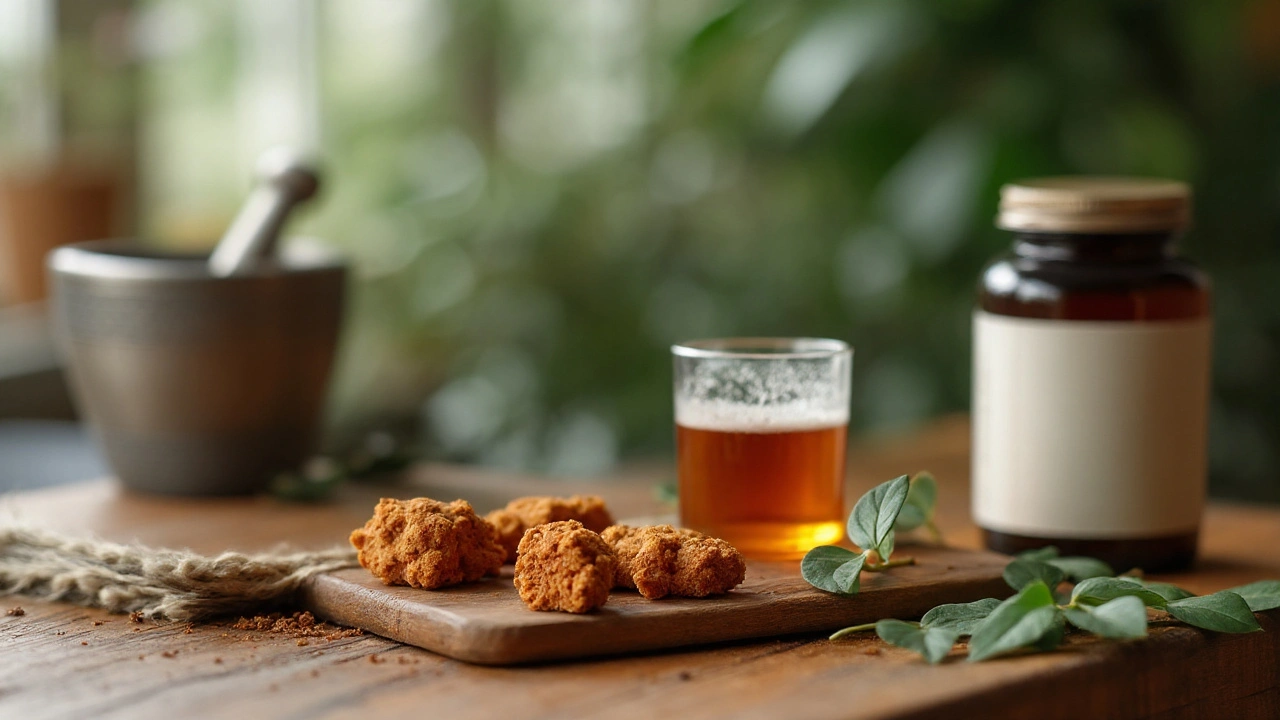TL;DR
- Quillaia (Quillaja saponaria) is a saponin-rich tree extract used in foods (E 999 foam agent) and as a vaccine adjuvant source-now sold as a supplement.
- Real, proven wins: beverage foaming/emulsifying; vaccine adjuvant via injection (QS-21). Oral supplement benefits (cholesterol, cough, immunity) are suggestive but not well-proven in humans.
- Safety matters: saponins can irritate the gut and, at high doses, damage red blood cells in lab settings. Start low, avoid if pregnant/ulcer-prone, and check meds.
- What helps most people: pairing diet fiber/sterols for cholesterol; classic cough care for colds; consider quillaia only as an add-on, not a hero ingredient.
- Buy smart: choose standardized extract, third-party tested, sustainably sourced from Chile; follow label dosing and stop if you feel GI distress.
What quillaia is-and why people are suddenly talking about it
A vaccine ingredient started showing up in supplement aisles. That’s the short version of the “Quillaia Revolution.” Quillaia (Quillaja saponaria) is a Chilean soapbark tree extract packed with saponins-natural surfactants that foam, emulsify, and interact with cell membranes. Food scientists have used quillaia for decades to stabilize soft drinks and boost foam in beverages (approved as food additive E 999 in the EU). Immunologists know it as the plant behind QS-21, a purified saponin fraction used as an adjuvant in modern vaccines.
So, what changed? Two things. First, wellness brands started bottling quillaia as a daily supplement for cholesterol, cough support, and immunity-piggybacking on saponin science. Second, more consumers learned that parts of the Shingrix vaccine’s adjuvant system are derived from Quillaja saponins, which sounds impressive. But here’s the catch: the way saponins work in an injected adjuvant is not the same as swallowing a capsule. Different route, different concentration, different effects.
Regulators have been clear about where quillaia fits today. The European Food Safety Authority re‑evaluated quillaia extract (E 999) for food use and judged it acceptable at current exposure levels in beverages. The FAO/WHO expert committee (JECFA) has assessed quillaia extracts for food applications, too. In the U.S., the FDA lists quillaia extract among permitted flavoring substances and adjuvants in the Code of Federal Regulations for food use. None of those rulings mean high-dose supplements are automatically safe or effective. They mean: okay in small food amounts, under specific specs.
What about tradition? Herbalists have long used quillaia bark teas as expectorants-the mild gastric irritation from saponins can trigger a reflex that thins bronchial secretions. But “used traditionally” is not the same as “clinically proven.” It’s a starting point for research, not a finish line.
What’s real vs hype: benefits you can expect (and what to skip)
Let’s set expectations like adults. Saponins are interesting molecules. They bind bile acids, can alter lipid absorption, and change membrane permeability. Those features help beverages stay stable and vaccines wake up the immune system. But when you swallow them in modest doses, the outcomes are more modest, and the data in humans is thin.
Where quillaia may help a bit:
- Cholesterol support (adjunctive): Saponins can bind bile acids in the gut, a mechanism similar to how dietary fiber lowers LDL. Animal studies with Quillaja saponins have shown drops in total cholesterol. Human trials specific to quillaia are scarce, small, and not definitive. If you already eat high fiber and consider phytosterols, quillaia could be a cautious add-on-think incremental, not transformational.
- Cough/expectorant: The old-school logic checks out: irritating the stomach slightly can stimulate bronchial secretions. Some people notice looser phlegm with saponin-rich herbs. But if your throat is raw or your stomach is touchy, that same irritation can feel lousy. Honey, steam, and hydration still carry the strongest safety-to-benefit ratio.
- Emulsion/absorption effects: Saponins can enhance penetration of some compounds across membranes. In theory, quillaia might modestly change how you absorb certain lipids or plant actives. In practice, this is unpredictable and not a reason alone to take it.
Where the hype runs ahead of proof:
- “Immune booster”: The adjuvant fame (QS‑21) is real-but that’s an injected, highly purified fraction formulated with other lipids, not an oral supplement. Don’t expect vaccine-like immune modulation from capsules.
- “Weight loss”: No good human evidence. Any change likely comes from better diet and fiber, not quillaia.
- “Detox”: A marketing word, not a physiological endpoint. Your liver and kidneys handle detox; quillaia doesn’t “flush” toxins.
Who tends to feel something? People who are already close to the basics-adequate fiber, consistent meals, and hydration-may notice small gains in LDL or mucus clearance. Who likely won’t? Anyone hoping quillaia replaces statins, fixes chronic asthma, or short-circuits a cold. That’s not how it works.
Safety snapshot grounded in how saponins behave:
- Gut irritation: The same property that thins mucus can upset the stomach. Start low, take with food, and stop if you feel cramping, nausea, or diarrhea.
- Red blood cells: Saponins are hemolytic at high concentrations in vitro. Normal food-level intake isn’t a problem; mega-dosing is unwise.
- Liver: High-dose animal data show possible liver irritation. If you’re on hepatotoxic meds, have liver disease, or drink heavily, avoid or talk to your clinician first.
- Pregnancy/kids: Skip it. Safety data are not strong enough to justify use.
What we can point to with confidence: EFSA’s re-evaluation found no safety concern at current food uses for E 999; the FDA permits quillaia as a food flavoring/foaming agent under specific conditions; the New England Journal of Medicine published Shingrix trials showing high efficacy in older adults with an adjuvant system that includes a Quillaja saponin fraction (QS‑21). Those are solid. Translating them into “this pill changes your life” is a leap.
| Use case | Evidence in humans | Typical label dose seen in 2025 | Time to notice | Alternatives with better proof |
|---|---|---|---|---|
| LDL support | Limited; mostly mechanistic/animal | 50-200 mg quillaia extract/day (10-25% saponins) | 4-8 weeks | Soluble fiber (5-10 g/day), phytosterols (1.6-2.4 g/day), statins if prescribed |
| Cough/phlegm | Traditional use; few modern trials | Small divided doses with food | Hours-days | Honey, humidification, guaifenesin, rest, fluids |
| “Immune boost” | No oral supplement proof | Not applicable | Not applicable | Vaccination, sleep, protein adequacy, exercise |
| Food emulsifier/foam | Strong; approved additive (E 999) | Food-use level, not supplement | Immediate | - |

How to use quillaia safely: dosing, side effects, and smart stacking
First, the adult basics. There’s no official clinical dose for quillaia as a dietary supplement. Product labels vary because extracts vary. A safe, sensible approach is to treat it like a strong, niche herb and move deliberately.
- Check your goal. If it’s LDL support, you’ll get more mileage from fiber and sterols. Quillaia can be a minor extra, not the engine.
- Screen yourself. Avoid if you’re pregnant, nursing, giving it to kids, have active ulcers/IBD, or a history of liver issues. If you’re on meds (especially those with a narrow therapeutic window), talk to your clinician first.
- Pick a standardized extract. Look for saponin content on the label (e.g., 10-25%). The more transparent the spec, the better you can dose consistently.
- Start low. Begin at the low end of the label-often 50-100 mg extract once daily with food. Stay there for a week before considering a step up. More is not better with saponins.
- Pair with a buffer. Take with a protein-containing meal and adequate water. If your gut is sensitive, space it away from coffee and NSAIDs.
- Cycle and reassess. Use for 8 weeks, then take a 2-4 week break. Track a concrete metric (LDL lab, cough symptom score, or simple daily notes).
- Watch for red flags. Stop if you notice persistent nausea, cramping, dark urine, yellowing eyes, or unusual fatigue. Seek care for severe symptoms.
Smart stacks by goal:
- LDL support “lite” stack: Oat beta-glucan (3 g/day), phytosterols (2 g/day), Mediterranean-style diet, walking after meals. Add quillaia only if you tolerate it and want that last 2-3% nudge. Recheck lipids in 8-12 weeks.
- Cough support kit: Honey (½-1 tsp, three times daily), steamy showers, nasal saline, sleep. If adding quillaia, use tiny doses with food and stop at any stomach pushback.
- Digestive comfort: If quillaia bothers your stomach, don’t force it. Ginger tea, peppermint (unless reflux), and simple foods do more with fewer risks.
Interactions and timing rules of thumb:
- Drug absorption: Saponins can change membrane permeability. Separate quillaia and critical meds by at least 3 hours.
- Liver load: Be cautious if you take acetaminophen daily, azoles, or other hepatically metabolized drugs. If you must try quillaia, do so under supervision and for short windows.
- Exercise: If you train hard, try your dose away from workouts to avoid GI noise mid-session.
How I’d talk to a friend: If you love to tinker and your basics are locked in, a small, time-limited trial of quillaia can be interesting. If you’re still skipping sleep, barely eating fiber, and hoping a capsule fixes cholesterol or a cough, save your money.
Buying guide and real-world plans: brands, alternatives, checklists, and answers
Quality varies a lot. Here’s how to pick a product without getting burned.
- Standardization matters: Look for total saponins on the label. “Quillaja extract” without a percentage is a shrug.
- Third-party testing: Choose products verified by USP, NSF, or an equivalent lab for identity and contaminants (heavy metals, pesticides).
- Sustainability: Quillaja saponaria is native to Chile. Prefer suppliers that source from managed plantations or certified sustainable harvests, and that disclose origin.
- Clean excipients: Skip products with unnecessary artificial colors or proprietary blends that hide actual dosages.
- Form factor: Liquids let you micro-dose; capsules are convenient but less flexible. Start with forms you can titrate.
Red flags:
- “Immune booster like a vaccine” claims-scientifically wrong for oral products.
- Megadose bragging-more saponins mean more irritation, not more benefits.
- No contact info, no batch numbers, no lot testing-hard pass.
Simple plans you can actually follow:
- Curious but cautious (LDL angle): For 8 weeks, keep a daily fiber log (aim 25-38 g/day), add phytosterols (2 g), walk 20 minutes after dinner. Add a quillaia supplement at 50 mg standardized extract with breakfast. If your stomach is fine after a week, you may try 100 mg. Get lipids checked before and after.
- Cough-prone in winter: Stock honey, saline, and a humidifier. If you experiment with quillaia, do it on a low-symptom day first-50 mg with food-to test tolerance. Don’t use if you have reflux flares.
- Sensitive stomach: Skip quillaia. Try oat beta-glucan for cholesterol or guaifenesin for mucus-both have gentler GI profiles.
| Decision factor | Go with quillaia | Pick an alternative |
|---|---|---|
| Primary goal is LDL reduction | You tolerate saponins; you’re already on fiber/sterols and want a small add-on | If you have GI sensitivity or want proven magnitude of effect (e.g., statins, ezetimibe) |
| Primary goal is cough | Mild chest congestion, robust stomach, short-term use | Reflux, gastritis, or you need a child-safe option |
| Immune support | Not recommended as a primary immune tool | Vaccination, sleep optimization, protein adequacy |
| Budget/Value | You’ve covered basics and want to experiment | You prefer investing in staples (fiber, quality diet, sleep) |
Mini‑FAQ (the questions people actually ask):
- Is it the same as QS‑21 in vaccines? No. QS‑21 is a purified fraction used by injection with a specific formulation. A capsule is not equivalent.
- What dose is safe? There’s no official supplement dose. Many labels land at 50-200 mg extract per day. Start low, use with food, and don’t exceed the label.
- Can I take it with statins? Maybe, but separate dosing by a few hours and tell your prescriber. Monitor lipids and watch for GI issues.
- Can kids take it? Don’t. Data are too thin to justify use in children.
- Is it okay in pregnancy? Avoid. Not enough safety data.
- Will it upset my stomach? It might. If you’re sensitive, choose other options.
- Is food-grade the same as supplement-grade? No. Food-grade E 999 is standardized for beverage use. Supplement products vary; buy tested, transparent brands.
Credible references behind this guidance: EFSA’s re-evaluation of quillaia extract as E 999 for food use (safety at current exposures); JECFA assessments for quillaia in foods; FDA’s listing of quillaia extract among permitted flavoring substances; and NEJM-published Shingrix trials showing high efficacy with an adjuvant system that includes a Quillaja saponin fraction. Those are primary, authoritative sources. They support safety at food levels and the vaccine story-not high-dose supplement promises.
Next steps by persona:
- The cautious beginner: Fix fiber, track steps, sleep 7-8 hours. If you still want to try quillaia, pick a standardized, third‑party tested extract, start at 50 mg with food, and keep a one‑line daily tolerance log.
- The data-driven tinkerer: Get a baseline lipid panel. Run an 8‑week n=1 with fixed diet/activity, add quillaia at 50-100 mg/day, and repeat labs. Stop immediately if GI or liver symptoms appear.
- The sensitive gut: Skip quillaia and lean on oat beta‑glucan, psyllium, and honey/steam for coughs. Your comfort is worth more than novelty.
- On multiple meds: Bring the bottle to your clinician. Ask about timing gaps and liver monitoring. Consider avoiding unless there’s a clear, measurable goal.
Quick checklist before you buy:
- Goal written down (what will you measure?)
- Standardized saponin % on the label
- Third‑party testing (USP/NSF or equivalent)
- Origin transparency and sustainability
- Plan for start‑low titration and an 8‑week reassessment








Maribeth Cory
August 29, 2025 AT 23:06Great rundown on quillaia – I love how you broke down the hype from the real data. It’s refreshing to see a balanced view that reminds us to keep the basics in check. If someone’s already eating plenty of fiber and using sterols, a tiny dose of standardized extract can be a nice little boost. Just remember to listen to your gut and stop if any irritation shows up. Keep experimenting, but stay safe and enjoy the small wins!
andrea mascarenas
August 30, 2025 AT 04:39Start low and watch your stomach.
Vince D
August 30, 2025 AT 10:13Quillaia’s a neat supplement, but it’s not a miracle pill. Stick with proven basics and use it as a tiny add‑on if you’re curious.
Camille Ramsey
August 30, 2025 AT 15:46Yo dude stop actin like a snack‑guru when the data barely says “maybe”. The gut irritation thing ain’t a joke, it can mess up your day. If you want results, test it seriously, not just slap a capsule on and hope.
Scott Swanson
August 30, 2025 AT 21:19Sure, because popping a plant extract is exactly what the CDC recommended for immune health. The sarcasm’s real – just don’t expect a vaccine‑level boost.
Karen Gizelle
August 31, 2025 AT 02:53Let’s be crystal clear: marketing hype does not equal scientific validation. The fact that quillaia appears in a vaccine adjuvant is fascinating, but the context matters – an injected, highly purified fraction is not comparable to an oral capsule. When you ingest saponins, they encounter digestive enzymes and the gut barrier, which dramatically alters bioavailability. The modest cholesterol‑binding effect observed in animal studies does not automatically translate to a clinically meaningful reduction in LDL for humans, especially when safer, well‑studied options like soluble fiber or statins exist. Likewise, the traditional cough‑relief claim hinges on mild gastric irritation, a mechanism that can backfire for anyone with a sensitive stomach or acid reflux. It’s irresponsible to label quillaia an “immune booster” when oral administration lacks robust data and the immune system already has proven supports: vaccination, adequate sleep, and balanced nutrition. Moreover, the reported hemolytic activity of saponins at high concentrations is a red flag; while typical supplement doses are far lower, the safety margin is narrow enough to warrant caution, especially for individuals on hepatotoxic medications. Pregnant and lactating people should steer clear due to insufficient safety evidence. The ethical thing to do is to prioritize transparency: manufacturers must clearly state saponin percentages, use third‑party testing, and avoid grandiose claims. Consumers deserve honest information to make informed choices. Until large, well‑controlled human trials demonstrate clear benefits that outweigh risks, quillaia should remain a niche supplement for those already comfortable with its mild effects, not a first‑line therapy. In short, respect the science, respect your body, and don’t let clever marketing replace proven health strategies.
Stephanie Watkins
August 31, 2025 AT 08:26I appreciate the thoroughness of the guide and the emphasis on tracking personal response. It’s wise to set a clear goal and measurable outcomes before adding any new supplement. Also, keeping a journal of any GI changes can help you decide quickly whether to continue. Thanks for the practical checklist!